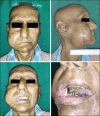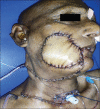Mango-shaped Bi-paddled pectoralis major myocutaneous flap reconstruction for large full-thickness defects post resection of squamous cell carcinoma of oral cavity: An analysis of 232 cases
- PMID: 36051791
- PMCID: PMC9426701
- DOI: 10.4103/njms.njms_374_21
Mango-shaped Bi-paddled pectoralis major myocutaneous flap reconstruction for large full-thickness defects post resection of squamous cell carcinoma of oral cavity: An analysis of 232 cases
Abstract
Objectives: The objective of the study was to examine the feasibility of bi-paddled pectoralis major myocutaneous (PMMC) flap reconstruction in patient undergoing full thickness composite resection.
Materials and methods: Inclusion criteria: The subjects chosen were patients with clinically T4A squamous cell carcinoma of buccal mucosa, lower alveolus, and maxilla in with skin involvement. Patients required a full-thickness composite resection of intraoral lesion, bone (mandibular segment and/or maxilla), and overlying involved skin and had modified radical neck dissection. Exclusion criteria: Patients not requiring full thickness composite resection including skin. Patients were observed postoperatively for early and late postoperative complications, starting of oral feeding, post-operative trismus, and dysphagia during subsequent follow-up and cosmetic outcome.
Results: Overall, the complication rate was 33.8% out of which only 7.8% required major re-surgery with second flap reconstruction. This is comparable with other large series of PMMC flap. Clavien-Dindo Grade I complications were seen in 9.5%, Grade II in 69.7%, Grade IIIA in 13.4%, and Grade IIIB in 7.45% of patients. Full-thickness partial flap necrosis included necrosis of either the external or the internal skin paddle. There were 15 cases - 6.5% of full thickness external paddle necrosis. These were mostly in patients with bite composite resections and having a larger random fasciocutaneous distal component of the flap without underlying muscle. Furthermore, 40% of these patients were females. In females, the flap necrosis comprised 4 of the 12 patients (33.33%).
Conclusion: Pectoralis major mycocutaneous flap has been a boon to reconstruction of the oral cavity post its inception. In case of locally advanced squamous cell carcinomas of the oral cavity, in many instances, there is a clinically significant cervical lymph nodal spread vessels post mandating a comprehensive lymph node dissection. PMMC flap provides a robust well vascularized muscular cover to the cervical vessels poststernocleidomastoid excision.
Keywords: Bi-paddled pectoralis major myocutaneous flap; oral cavity; squamous cell carcinoma.
Copyright: © 2022 National Journal of Maxillofacial Surgery.
Conflict of interest statement
There are no conflicts of interest.
Figures







References
-
- Ariyan S. The pectoralis major myocutaneous flap. A versatile flap for reconstruction in the head and neck. Plast Reconstr Surg. 1979;63:73–81. - PubMed
-
- Freeman JL, Gullane PJ, Rotstein LM. The double paddle pectoralis major myocutaneous flap. J Otolaryngol. 1985;14:237–40. - PubMed
-
- Patil VM, Prabhash K, Noronha V, Joshi A, Muddu V, Dhumal S, et al. Neoadjuvant chemotherapy followed by surgery in very locally advanced technically unresectable oral cavity cancers. Oral Oncol. 2014;50:1000–4. - PubMed
LinkOut - more resources
Full Text Sources
